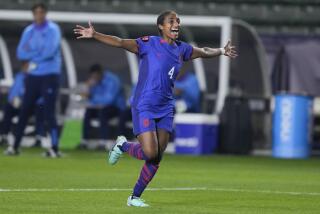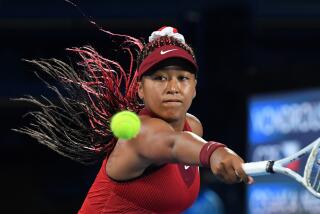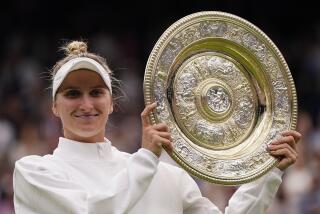Navratilova Enjoys New Role : U.S. Open: At 34, the former champion is considered an underdog to win another title. But she’s one of only four left with a chance to do just that.
- Share via
NEW YORK — OK, go with it if you want, but this Jimmy-Martina thing doesn’t really work. They’re going to package them to the hilt--this revenge of the middle-aged herd --and, hey, it’s a demographic work of art aimed squarely at the wallet of every baby-boomer tennis fan, but, I’m telling you, it’s bogus.
Connors may be in the business of miracles, but Navratilova still plays tennis. They don’t belong in the same glory-days nostalgia piece. Connors, at 39, is truly, legitimately, no-time-left-on-the-meter, what’s-he-still-doing-here old. But Navratilova, at 34, is a threat.
Every minute Connors remains standing is a victory. It’s look, he’s still there. Still strutting and still swearing. But, by God, still there.
Navratilova, on the other hand, is out to win a tournament. Don’t laugh. Believe me, no one who has to play her is going to laugh.
She’s the fifth-best women’s tennis player in the world. And when she beat the No. 4 seed here Wednesday, nobody was suggesting it was an upset. It was Martina. She’s here and she’s dangerous. Why not? She’s at a dangerous age.
“I’m a spring chicken next to him,” she said of Connors, and she is.
Jimmy is a dream come true. Navratilova is a nightmare awaiting everyone who plays her.
But the crowd makes no such distinction. Give the Connors love-in a day off, and the folks who fill the stadium court filled the void with Navratilova, another player to put them in mind of their youth.
And so it was that Navratilova -- running to the net to play that same old serve-and-volley game -- held the crowd in thrall for three sets, two of them decided in tie-breakers, as she beat Arantxa Sanchez Vicario. The win put Navratilova in the semifinals, as of old, and it felt good to the fans, if not quite as good as a Connors win would. Navratilova even played to the crowd in Connors style after the match, with a racket salute to each corner of the stadium.
Navratilova loves that the crowd loves her. There were many years when she felt unloved. And in this year of the palimony suit and all the negatives that have gone with it, she needs some affection, even if it’s just for growing old and maybe for surviving.
“I just wore them down,” she said of the fans and their change of heart over the years. “No, I think part of it was the kind of game that I played, who I was up against, which was Chris (Evert), who was everybody’s heroine and the girl next door. And the kind of game that I played was deemed masculine and overpowering and big, and you know I was muscular as well. It just seemed to go against the American grain.
“Now other girls are bigger, and I’m not so big anymore. And there is much more understanding of where I am coming from and what is going on with me as a human being. And there’s a lot more respect. At the same time, the underdog syndrome comes in. There is no doubt about that. It is much easier to cheer for the underdog than for the No. 1. The crowd relates to the underdog because most people are underdogs.”
There’s nothing wrong with that. And there’s nothing wrong with Navratilova getting to enjoy it. If she and Connors have accomplished anything here in tandem, it is that older athletes should enjoy, if they wish, being older athletes. It’s good to have players around who remember a time before MTV. Why would anyone want to push Navratilova out of the picture before she’s ready? But they do. They do.
“I have been getting that question since I was about 27,” she said, sitting at a news conference, where she’s as good as she is on court. “It has always puzzled me why it is so necessary for athletes to stop at their prime. How do you know that that is the end of the prime or that you have even approached it? And once you quit, you can’t go back. You can’t say, ‘No, I want to be 25 again or 35 again.’ Those years are gone forever. And, you know, you don’t do that to surgeons or doctors or lawyers or writers.
“I think obviously you lose a little bit when you get older, but you gain things. Maybe you don’t play the same way, but maybe you play better when you are 40 than when you were 30. And the bottom line is that Jimmy has a great time playing tennis, and it doesn’t matter if he is 9 or 900. I feel the same way.”
Sure, part of it is an ex-champion talking herself into thinking she can be a champion again. But maybe she can. She won Wimbledon last year. She has to get by Steffi Graf and then the winner of Jennifer Capriati-Monica Seles. That’s a lot. It’s probably too much. But where does it say you have to be No. 1 to keep playing? Ask John McEnroe. Ask Pam Shriver.
Ask Martina.
“Hopefully, I’m not No. 5 anymore,” she said. “Maybe I will go up in the rankings. I don’t know. I’m still out there and still have a shot at winning every tournament I play in. As long as I feel that that is a possibility, then I’ll enjoy it and stay out there.”
More to Read
Go beyond the scoreboard
Get the latest on L.A.'s teams in the daily Sports Report newsletter.
You may occasionally receive promotional content from the Los Angeles Times.










